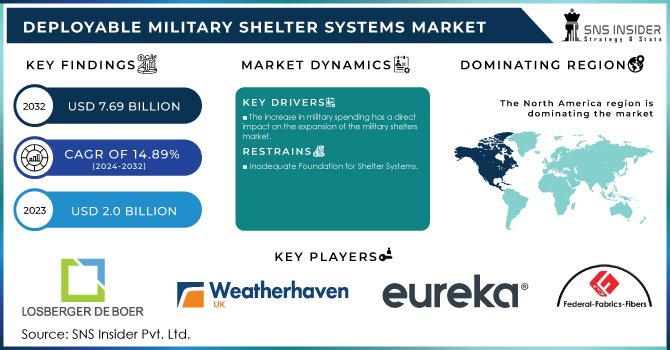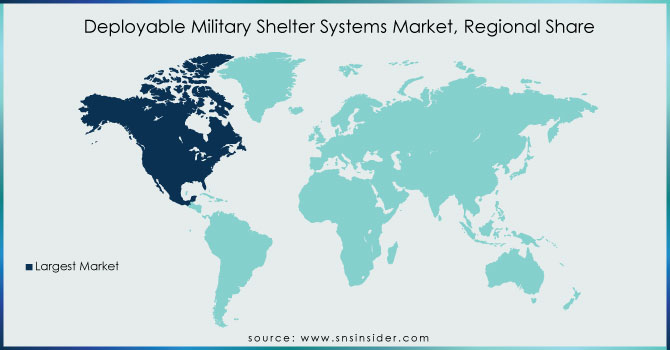Deployable Military Shelter Systems Market Report Scope & Overview:
The Deployable Military Shelter Systems Market Size was valued at USD 2.0 billion in 2023 and is expected to reach USD 7.69 billion by 2032 with an emerging CAGR of 14.89% over the forecast period 2024-2032.

To get more information on Deployable Military Shelter Systems Market - Request Free Sample Report
The deployable military shelter system is employed in a variety of settings, including medical support centre, incident command centre, and fatality management centre, as well as emergency distribution centre. These shelters are placed in distant areas for a limited duration. Military advancements, joint operations, exercises, and tactics promote the development of specialist items utilized by army troops. These movable shelter systems are comprised of technical textiles and are mostly utilized by infantry, medical support teams, and rescue teams. As the military funding for research and development has increased, the market has seen technological breakthroughs. These shelters are not only for use on ground, but have also been expanded to military vehicles and aeroplane.
MARKET DYNAMICS
KEY DRIVERS
-
The increase in military spending has a direct impact on the expansion of the military shelters market.
-
Stronger economies are allocating massive sums to their countries' defence budgets in order to strengthen national security.
RESTRAINTS
-
Inadequate Foundation for Shelter Systems
OPPORTUNITIES
-
Major marketers have noticeably improved the quality of material and utility for various objectives.
-
The beneficial properties of polymer fabric increase demand for the same.
CHALLENGES
-
Annual increases in defence budget allocation have been noted across countries, with the year-on-year increase being especially pronounced in countries with stronger economies.
-
Rising political and military tensions in several parts of the globe
IMPACT OF COVID-19
After the end of COVID-19, it is expected that manufacture of deployable military shelters will become more nimble.
Due to the shutdown, the supply chain interruption is projected to have an impact on the companies' future growth.
Revenue is not being created for the companies because to the ongoing epidemic, which will result in significant losses throughout the year.
To resurrect the market, companies must deal on a high margin.
Because of the lockdown, the income creation of deployable military shelter companies has suffered a significant financial loss.
The military and defence sectors around the world have been asking for deployable military shelters for a variety of uses, including people, vehicle-mounted, and aircraft base shelters, among others. This expanded applicability is due to the deployable shelters' great coverage and protection.
Furthermore, deployable shelters provide a tactical protection to military exercises and operation bases, resulting in a robust demand increase in the market. Furthermore, the flexibility of movable military shelters to suit well in distant and stealth missions expands market demand. Furthermore, the demand is spurred by the desire to gain an advantage over the adversaries, hence vehicle-mounted deployable metal shelters entered the picture, allowing for movable shelter protection. Military shelters are available in a variety of sizes and materials to meet a variety of demands. Small shelters are up to 6 metres in length, and large shelters are more than 6 metres. Because of its lightweight properties and high tensile strength, polymer fabric is expected to earn the largest revenue share in the global market. Despite the fact that nylon and polyester have similar properties, polyester remains the preferred alternative for the manufacture of deployable military shelters since it has shown to be efficient and can be easily recycled. Polymer fibre sales are predicted to double those of nylon material. Post of Command and Control The segment dominated the global market, and is predicted to grow at the fastest CAGR during the forecast period, owing to rising need for command and control positions for military strategy development and implementation.
Base Medical Facility The category is likely to expand during the forecast period as demand for deployable military shelter systems in medical crises increases for the army, air force, and navy. Vehicle and Aircraft Maintenance The demand for transportable military shelter systems is increasing for administering, commanding, and supervising army and air force bases or camps for mounted vehicle and aircraft maintenance. Others Vehicle mounted, container, aircraft base, people, and military camps are among the other segments. Shelter with a Rigid Wall The market was controlled by this segment. Heavy military equipment and aircraft are stored in hard wall shelters. Furthermore, these shelter systems provide increased security, propelling the segment's expansion.
Shelter with a Soft Wall Due to factors such as the lightweight of soft wall shelter systems and ease of installation in adverse weather situations to carry out various missions such as medical base camps and search and rescue, the segment is likely to display a higher CAGR during the forecast period.
KEY MARKET SEGMENTATION
By Size
-
Small
-
Medium
-
Large
By Industry Vertical
-
Military & Defense
-
Textile
-
Others
By Type
-
Rigid wall shelter
-
Soft wall shelter
By Material
-
Polymer Fabric
-
Nylon
-
Composite
By Application
-
Personnel
-
Vehicle Mounted
-
Medical Facility Base
-
Aircraft Base
-
Command Post
-
Others
REGIONAL ANALYSIS:
North America has the greatest market share of the overall deployable military shelter materials market. During the predicted period, North America is also expected to maintain its supremacy. The market for deployable military shelter materials is being driven by rising demand for militant security.
The United States is likely to make a substantial contribution to the worldwide deployable military shelter market during the forecast period. Rising demand for modern aircraft hangars and medical support systems for military applications is predicted to propel the country's deployable military shelter system market forward. The Asia Pacific transportable Military Shelter System market will expand rapidly. Furthermore, during the forecast period, the Asia Pacific market for aircraft and vehicle maintenance in deployable military shelters is predicted to develop at the quickest CAGR.
The continuing military modernization efforts in Asia Pacific are likely to enhance demand for shelter systems. Defense budget increases are likely to fuel the expansion of the deployable military shelter system market materials market. Furthermore, increased terrorism in Asia Pacific countries would fuel demand for deployable military shelter material throughout the projection period.

Need any customization research on Deployable Military Shelter Systems Market - Enquiry Now
REGIONAL COVERAGE:
-
North America
-
USA
-
Canada
-
Mexico
-
-
Europe
-
Germany
-
UK
-
France
-
Italy
-
Spain
-
The Netherlands
-
Rest of Europe
-
-
Asia-Pacific
-
Japan
-
south Korea
-
China
-
India
-
Australia
-
Rest of Asia-Pacific
-
-
The Middle East & Africa
-
Israel
-
UAE
-
South Africa
-
Rest of Middle East & Africa
-
-
Latin America
-
Brazil
-
Argentina
-
Rest of Latin America
-
KEY PLAYERS
The Major Players are US Military Tents, Berg and Losberger GmbH, Weatherhaven Global Resources Ltd., Eureka! Expeditionary Systems., Alaska Structures Inc., Federal-Fabrics-Fibers Inc., RDD USA, Shelter Tent Manufacturing Co. Ltd., CAMSS Shelters, HDT Global & Other Players
| Report Attributes | Details |
|---|---|
| Market Size in 2023 | US$ 2.0 Billion |
| Market Size by 2032 | US$ 7.69 Billion |
| CAGR | CAGR of 14.89% From 2024 to 2032 |
| Base Year | 2023 |
| Forecast Period | 2024-2032 |
| Historical Data | 2020-2022 |
| Report Scope & Coverage | Market Size, Segments Analysis, Competitive Landscape, Regional Analysis, DROC & SWOT Analysis, Forecast Outlook |
| Key Segments | • By Size (Small, Medium, Large) • By Industry Vertical (Military & Defense, Textile, Others) • By Type (Rigid wall shelter, Soft wall shelter) • By Material (Polymer Fabric, Nylon, Composite) • By Application (Personnel, Vehicle Mounted, Medical Facility Base, Aircraft Base, Command Post, Others) |
| Regional Analysis/Coverage | North America (USA, Canada, Mexico), Europe (Germany, UK, France, Italy, Spain, Netherlands, Rest of Europe), Asia-Pacific (Japan, South Korea, China, India, Australia, Rest of Asia-Pacific), The Middle East & Africa (Israel, UAE, South Africa, Rest of Middle East & Africa), Latin America (Brazil, Argentina, Rest of Latin America) |
| Company Profiles | US Military Tents, Berg and Losberger GmbH, Weatherhaven Global Resources Ltd., Eureka! Expeditionary Systems., Alaska Structures Inc., Federal-Fabrics-Fibers Inc., RDD USA, Shelter Tent Manufacturing Co. Ltd., CAMSS Shelters, HDT Global. |
| KEY DRIVERS | • The increase in military spending has a direct impact on the expansion of the military shelters market. • Stronger economies are allocating massive sums to their countries' defence budgets in order to strengthen national security. |
| Restraints | • Mro Of Aviation Engines Is Expensive. • Growing Environmental Dangers Related To Aviation Engine Mro Services |

